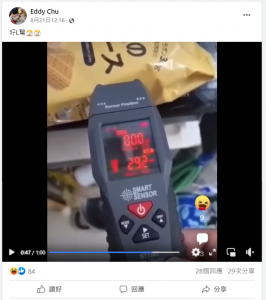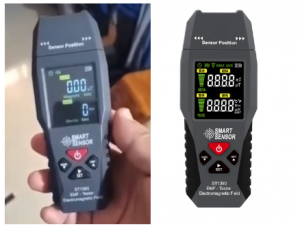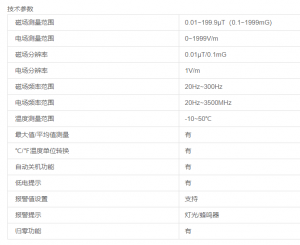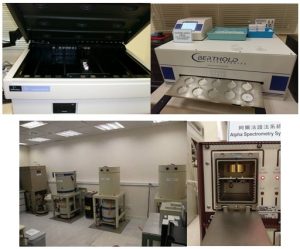發布日期 (HKT) 2023-10-06
Device used for detecting electromagnetic radiation rather than nuclear radiation
Screenshot of the viral video.
The claim: A video circulating online shows an individual using a “radiation detector” to test a bag of food labeled in Japanese characters. The “detector” then emitted beeping sounds, and the monitor displayed elevated values. The video creator advised against purchasing food manufactured in Japan, suggesting that its radiation levels have exceeded standards.
Fact-checking:
- The device in the viral video is actually an electromagnetic radiation detector. Electromagnetic radiation is non-ionizing radiation, which has low energy and only causes vibration in particles and a temperature rise.
- Mr. Leung Wai Hung, Senior Scientific Officer at the Hong Kong Observatory told HKBU Fact Check that radioactive pollution resulting from nuclear accidents is a form of ionizing radiation. Different from electromagnetic radiation, ionizing radiation refers to radiation that can harm biological tissues, with high doses capable of damaging cells or organs, and even causing death. An electromagnetic radiation detector cannot be used to measure the level of ionizing radiation.
Our verdict: The device featured in the viral video cannot detect radiation related to nuclear accidents; it actually detects electromagnetic radiation. Therefore, we rate the claim as FALSE.
News Brief
According to BBC, on Aug. 24, 2023, Japan began discharging treated radioactive wastewater from the Fukushima nuclear power plant into the Pacific Ocean. Japan’s decision to release treated radioactive wastewater has faced opposition from neighboring countries and regions, with concerns raised about the safety of the wastewater. A video circulating online shows an individual holding a so-called “radiation detector” to test a food package labeled in Japanese characters. The detector emitted beeping sounds. The video creator indicated that a high level of radiation was detected in the food and urged people not to purchase food manufactured in Japan.
As of the issuance of this report, the post had been shared 27 times, and had received 29 comments and 87 likes or reactions.
Fact-checking
A keyword search revealed that the device featured in the video is a radiation detector, specifically the Xima Instrument brand, model ST1393. It was also found that the product showcased on the official website of Xima Instrument and the device in the viral video both have the words “Electromagnetic field” printed on the bodies. According to the technical specifications provided on the brand’s official website, it is classified as an electromagnetic radiation detector and does not indicate the ability to detect ionizing radiation.
Comparison of the detector used in the viral video (left) and the product image showcased on the official website of Xima Instrument (right).
The technical specifications of the detector do not indicate the ability to detect ionizing radiation.
According to the information from the Hong Kong Observatory, radiation can be divided into two types: non-ionizing radiation and ionizing radiation. Non-ionizing radiation, such as light and radio waves, has low energy and is insufficient to alter the chemical properties of substances. In contrast, ionizing radiation, such as alpha and beta particles, has energy high enough to remove electrons from an atom, creating electronically charged ions. This ionization process typically leads to chemical changes in biological tissues, which can lead to injury in the organism. Ionizing radiation is generally referred as harmful radiation. Low-energy electromagnetic radiation falls under non-ionizing radiation, which contains low energy and only causes molecules to vibrate and induces heating effects. Examples of non-ionizing radiation are ultraviolet rays, visible light, infrared, microwaves, and radio waves.
Mr. Leung Wai Hung, senior scientific officer at the Hong Kong Observatory, told HKBU Fact Check that if a nuclear power plant accident leads to the release of artificial radionuclides, the resulting radiation is ionizing radiation. An article published by the Hong Kong Department of Health also refers to radiation related to nuclear accidents as ionizing radiation.
The International Atomic Energy Agency states that non-ionizing radiation includes visible light, radio waves, and microwaves. For most people, non-ionizing radiation does not pose a health risk. Ionizing radiation includes gamma (γ) rays used for treating certain types of cancer, X-rays, and radiation emitted from radioactive materials used in nuclear power plants. In high doses, ionizing radiation can damage cells or organs in the human body and even cause death.
Leung stated that detecting different types of radiation have different technical requirements, therefore, the use of different instruments is required for detection. Professional radiation detection instruments should possess an adequate level of accuracy and sensitivity and need to be regularly calibrated. The Hong Kong Observatory’s radiation laboratory at King’s Park has four major types of equipment used to accurately measure the electrical charges produced by the radiation emitted by radioactive materials present in the environmental samples. The four types of detection equipment are gamma spectroscopy system, liquid scintillation counting system, low level alpha-beta counting system, and alpha spectroscopy system.
The equipment used by the Hong Kong Observatory for detecting radioactive nuclides.
In summary, the instrument used in the viral video is an electromagnetic radiation detector, which cannot be used to detect ionizing radiation and therefore cannot detect radioactive contamination caused by a nuclear accident.
Conclusion
The device featured in the viral video cannot detect radiation related to nuclear accidents; it actually detects electromagnetic radiation.
References
- Facebook, post, Aug. 21, 2023.
- BBC, “Fukushima: What are the concerns over waste water release?” Aug. 31, 2023.
- Xima Instruments: ST1393 Electromagnetic Radiation Meter.
- Hong Kong Observatory, “What is Radiation?”
- Hong Kong Observatory, “Non-ionizing radiation.”
- International Atomic Energy Agency, “What is Radiation?”
- Hong Kong Observatory, “Laboratory measurement.”
















 :
: